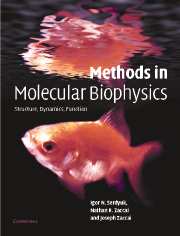Book contents
- Frontmatter
- Contents
- Foreword by D. M. Engelman
- Foreword by Pierre Joliot
- Preface
- Introduction: Molecular biophysics at the beginning of the twenty-first century: from ensemble measurements to single-molecule detection
- Part A Biological macromolecules and physical tools
- Part B Mass spectrometry
- Part C Thermodynamics
- Part D Hydrodynamics
- Part E Optical spectroscopy
- Chapter E1 Visible and IR absorption spectroscopy
- Chapter E2 Two-dimensional IR spectroscopy
- Chapter E3 Raman scattering spectroscopy
- Chapter E4 Optical activity
- Part F Optical microscopy
- Part G X-ray and neutron diffraction
- Part H Electron diffraction
- Part I Molecular dynamics
- Part J Nuclear magnetic resonance
- References
- Index of eminent scientists
- Subject Index
- References
Chapter E1 - Visible and IR absorption spectroscopy
from Part E - Optical spectroscopy
Published online by Cambridge University Press: 05 November 2012
- Frontmatter
- Contents
- Foreword by D. M. Engelman
- Foreword by Pierre Joliot
- Preface
- Introduction: Molecular biophysics at the beginning of the twenty-first century: from ensemble measurements to single-molecule detection
- Part A Biological macromolecules and physical tools
- Part B Mass spectrometry
- Part C Thermodynamics
- Part D Hydrodynamics
- Part E Optical spectroscopy
- Chapter E1 Visible and IR absorption spectroscopy
- Chapter E2 Two-dimensional IR spectroscopy
- Chapter E3 Raman scattering spectroscopy
- Chapter E4 Optical activity
- Part F Optical microscopy
- Part G X-ray and neutron diffraction
- Part H Electron diffraction
- Part I Molecular dynamics
- Part J Nuclear magnetic resonance
- References
- Index of eminent scientists
- Subject Index
- References
Summary
Brief historical review and biological applications
1704
In OpticksIsaac Newton dealt with the formation of a spectrum by a prism, and the composition of white light and its dispersion. The Latin word, spectrum, means an appearance; a spectrum is obtained when radiation is broken up into its colour or wavelength distribution.
1800
The astronomer, William Herschel, discovered infrared (IR) radiation.
1801
The physicist Johann Wilhelm Ritter discovered ultraviolet (UV) radia-tion.
1814
Joseph von Frauenhofer showed that the Sun's spectrum contained dark lines (later named Frauenhofer lines), indicating that light of the corresponding colour was missing because of absorption.
1850–1900
August Beer stated the empirical law, which was named after him, that there is an exponential dependence between the transmision of light through a substance, the concentration of the substance and the path length of the beam through it. The law is also known as the Beer–Lambert law or the Beer–Lambert–Bouguer law, in recognition of the work of Pierre Bouguer (1729) and Johann Heinrich Lambert (1760). Gustav Kirchhoff's discovery that each pure substance has a characteristic spectrum provided the basis for analytical spectroscopy. Gustav Kirchhoff and Robert Bunsen identified the chemical elements in the Sun by analysing its spectrum. Johann Jacob Balmer identified a numerical series in the spectrum of hydrogen. Joseph John Thomson discovered the electron. Max Planck introduced the concept of quanta in the treatment of heat radiation and laid the foundation of quantum theory. He was awarded the Nobel prize in 1918.
- Type
- Chapter
- Information
- Methods in Molecular BiophysicsStructure, Dynamics, Function, pp. 519 - 561Publisher: Cambridge University PressPrint publication year: 2007



